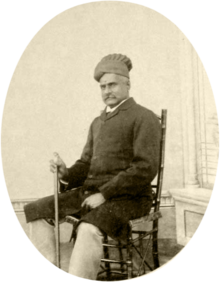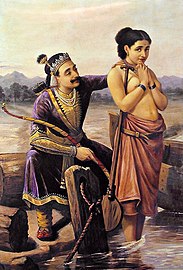
Raja Ravi Varma Koil Thampuran (29 April 1848 – 2 October 1906) was a celebrated Indian painter and artist. He is considered among the greatest painters in the history of Indian art for a number of aesthetic and broader social reasons. Firstly, his works are held to be among the best examples of the fusion of European techniques with a purely Indian sensibility.

Damayanti from Mahabharata
While continuing the tradition and aesthetics of Indian art, his paintings employed the latest European academic art techniques of the day. Secondly, he was notable for making affordable lithographs of his paintings available to the public, which greatly enhanced his reach and influence as a painter and public figure. Indeed, his lithographs increased the involvement of common people with fine arts and defined artistic tastes among common people for several decades. In particular, his depictions of Hindu deities and episodes from the epics and Puranas have received profound acceptance from the public and are found, often as objects of worship, across the length and breadth of India.

Sri Shanmukha Subramania Swami
Raja Ravi Varma was closely related to the royal family of Travancore in the deep south of India (Kerala and Tamil Nadu). Later in his life, two of his granddaughters were adopted into that royal family, and their descendants comprise the totality of the present royal family of Travancore, including the latest three Maharajas (Balarama Varma III, Marthanda Varma III and Rama Varma VII)Raja Ravi Varma was born as Ravi Varma Koil Thampuran at Kilimanoor palace in the erstwhile princely state of Travancore (present-day Kerala). He was born into an aristocratic family, where the men held the title of Koil Thampuran (sacred prince) and women held the title of Thampuratti (the female form of Thampuran). His family belonged to the Nair caste, the land-owning aristocracy of Travancore Kingdom, which follows the matrilineal Marumakkathayam tradition, under which family affiliation and succession to estates is determined by descent through women. Thus, Ravi Varma belonged to the family of his mother (not his father), and his children belonged to the family of their mother (not his own).

The Maharashtrian Lady
Ravi Varma was the son of Ezhumavil Neelakanthan Bhattatiripad, a Brahmin gentleman, by his Nair wife Umayamba Thampurratti. His mother, Uma Ambabayi Thampuratty (or Umayamba Bayi Thampuratty), belonged to the baronial family which ruled the Kilimanoor feudal estate within the kingdom of Travancore. She was a poet and writer of some talent, whose work Parvati Swayamvaram was published by Varma after her death. In keeping with the Sambandam tradition of matrimony which was prevalent in those days, she was married to a Brahmin gentleman in preference to a man of her own Nair caste. Ravi Varma's father, Ezhumavil Neelakanthan Bhattatiripad, was a Namboodiri Brahmin and a very learned scholar of Sanskrit and Ayurveda who hailed from the Ernakulam district in Kerala. Ravi Varma had three siblings, a sister named Mangala Bayi, and two brothers named Goda Varma (born 1854) and Raja Varma (born 1860). The last-named was also a painter and worked closely with Ravi Varma all his life.

Shantanu and Satyavati from Mahabharata
In 1866, at the age of 18, Varma was married to 12-year-old Bhageerthi Bayi (known formally as Pooruruttati Nal Bhageerathi Bayi Thampuratty) of the royal house of Mavelikkara, another major fief of Travancore kingdom. Notably, the house of Mavellikara was a branch of the Royal House of Travancore. Bhageerthi was the youngest of three sisters, and both of her elder sisters had been adopted into the royal family of Travancore in 1857, in order to carry on the lineage. They were known as the Senior and Junior Rani of Attingal, and in their progeny was vested the succession to the throne of Travancore. Therefore, Ravi Varma's connection to the royal family became very close due to his marriage with Bhageerthi. Indeed, his children (because they belonged to their mother's family) would be royal by birth. The marriage, which was arranged by their parents in the proper Indian manner, was harmonious and successful. The couple were blessed with five children, being two sons and three daughters. Their elder son, Kerala Varma (b.1876) was of an excessively spiritual temperament. He never married and eventually renounced the world, leaving home for good in 1912. The younger son, Rama Varma (born 1879), inherited his father's artistic talent and studied at the JJ School of Arts, Mumbai. He was married to Gowri Kunjamma, sister of Dewan PGN Unnithan, and became the father of seven children.

Woman Holding a Fruit
It was however Ravi Varma's daughters who were singled out by destiny for greatness, although not in the field of art, and not personally but through their daughters. The three daughters of Ravi Varma and Bhageerthi Bayi were Mahaprabha Amma (who features in two of Varma's most famous paintings), Uma Amma (named after Varma's mother) and Cheria Kochamma. In 1900 CE, the Royal House of Travancore once again faced a succession crisis. Bhageerthi's two elder sisters, who had been adopted in order to carry forward the lineage, had failed to produce the desired heirs. They had had six children between them, but only two of those had survived, and both were boys (who also, incidentally, later died childless). According to the matrilineal Marumakkathayam system, the succession to the throne could only progress through females, and therefore it was necessary to make an adoption. Tradition dictated that two girls belonging to branches of the Royal Family be adopted together. They would be designated the Senior and Junior Rani of Attingal, and the succession to the throne of Travancore would be vested in their progeny, in accordance with the unusual and unique Marumakkathayam system of succession.

Two of Verma's grand-daughters were called by destiny to receive this surpassing honour, the main reason being that they were the nearest matrilineal (cognatic) kin to the incumbent Rani of Attingal. In August 1900, Mahaprabha's eldest daughter Lakshmi Bayi (aged 5 years) and Uma's eldest daughter Parvati Bayi (aged 4 years) were adopted into the Royal family of Travancore. It was Bharani Thirunal Lakshmi Bayi, their surviving grand-aunt, who formally adopted them. She died within one year of doing this, and the two girls were then installed as the Senior and Junior Ranis of Attingal respectively. They were married while yet in their early teens to two Nair gentleman from suitable aristocratic families. It was the Junior Rani, Sethu Parvathi Bayi, who gave birth to the much-awaited heir in 1912, exactly the day after her sixteenth birthday. Incidentally, her husband was a grand-nephew of Raja Ravi Varma and belonged to Kilimanoor. The new born child was the future Maharaja Chitra Thirunal, the last ruling Maharaja of Travancore. He was followed by a brother (the future Maharaja Marthanda Varma III) and a sister Lakshmi Bayi, the mother of Maharaja Rama Varma VII who is presently on the throne (since 2013). Meanwhile, the Senior Rani (Sethu Lakshmi Bayi, daughter of Mahaprabha Amma, and Regent in the period 1924-31) also gave birth to two daughters later in life (in 1923 and 1926).
In this way, the entire present (existing) royal family of Travancore are descended from Raja Ravi Varma. Well known among his royal descendants are the writers Aswathi Thirunal Gowri Lakshmi Bayi and Shreekumar Varma, the artist Rukmini Varma and the classical musician Aswathi Thirunal Rama Varma.
No comments:
Post a Comment